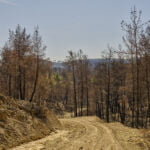
A significant portion of time, resources, and money spent by a wildfire agency is dedicated towards wildfire response. Therefore, optimizing and maximizing the effectiveness of response activities and strategies is of great importance. Incremental gains in response activities can have a compounding positive effect on the outcome of their response efforts.
FPInnovations’ Wildfire Operations Research group partners with wildfire agencies across Canada to conduct operational research on wildfires. Among the several themes of research, a considerable component of the work performed looks at improve two key aspects of wildfire response – (1) aviation and wildfire chemicals, and (2) technology and innovation in equipment.
Aviation and wildfire chemicals
Aviation assets such as helicopters and airtankers are expensive but extremely effective tools used by wildfire agencies to respond to wildfires. The main objective of aviation assets is to slow down the growth of a wildfire by dropping water, water-based products, or retardants on or ahead of the wildfire. This is done so that ground crews can safely and effectively suppress and extinguish the wildfire. Due to the tremendous expense involved in the procurement, maintenance, and operation of aviation assets, marginal gains in performance and effectiveness can result in significant cost savings.
One avenue explored by the Wildfire Operations Research group to optimize the use of aviation assets is in the domain of wildfire chemicals (i.e., water-based products). Wildfire chemicals are additives to water that can potentially help improve the performance of water in suppressing a wildfire. These wildfire chemicals improve the drop characteristics of water, thereby offering efficacies in operations.
At FPInnovations, only wildfire chemicals that are supported through the U.S. Forest Service (USFS) qualification process are studied. Canadian wildfire agencies only use those products that adhere to the USFS safety and performance standards. FPInnovations researchers break down the various characteristics of these wildfire chemicals to see which ones are most effective. First, the wildfire chemicals are evaluated for their performance in a laboratory setting. Simultaneously, rheological properties of these wildfire chemicals such as viscosities and response to water hardness are assessed. Once laboratory results are in, FPInnovations researchers transition to field testing of wildfire chemicals from aviation assets. In 2020, a series of field evaluation of drop characteristics in open-field and forested-stand settings were conducted from Sikorsky S-61 ‘heavy’ helicopters.
Environmental considerations
The wildfire chemicals used in aviation response operations undergo a rigorous vetting process conducted by the U.S. Forest Service. Each wildfire chemical is put through a gamut of tests – ranging from corrosion to environmental impacts (mammalian and aquatic toxicity, ecological risk assessments, etc.). This process can take up to two years for qualification and approval for use from aviation assets.

Technology and innovation in equipment

The Wildfire Operations Research group works on behalf of government agencies to be the first to trial new technology and innovation in an operational environment, assess their efficacy, and deliver key information on their value to a wildfire response agency.
For more information, contact Razim Refai, Researcher in FPInnovations’ Wildfire Operations Research group.






